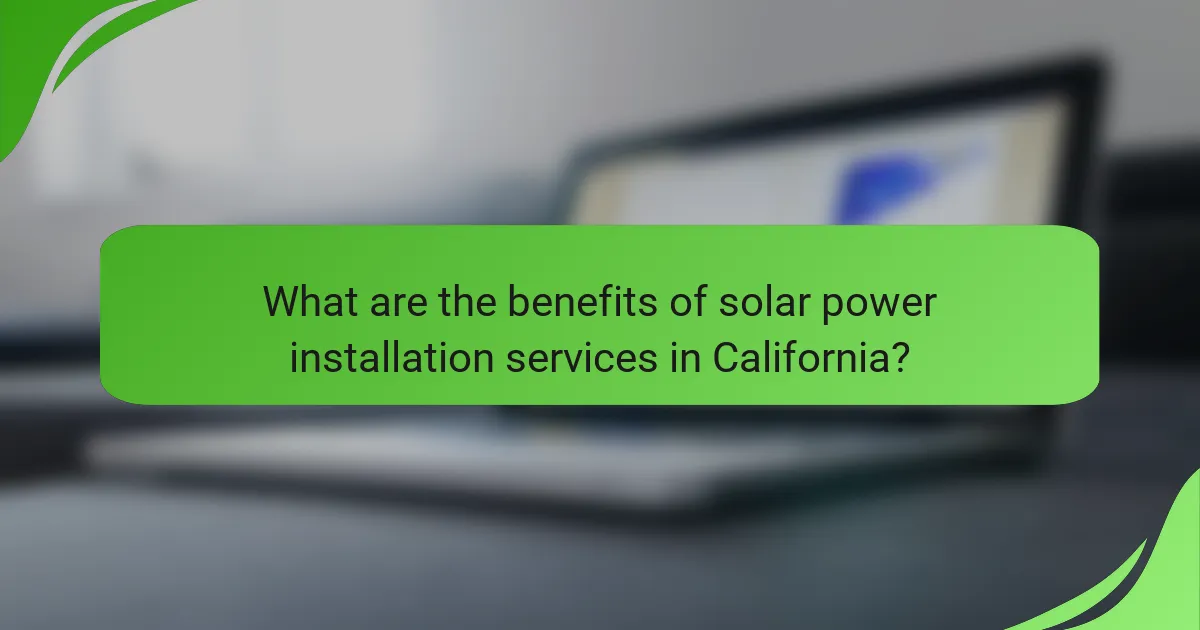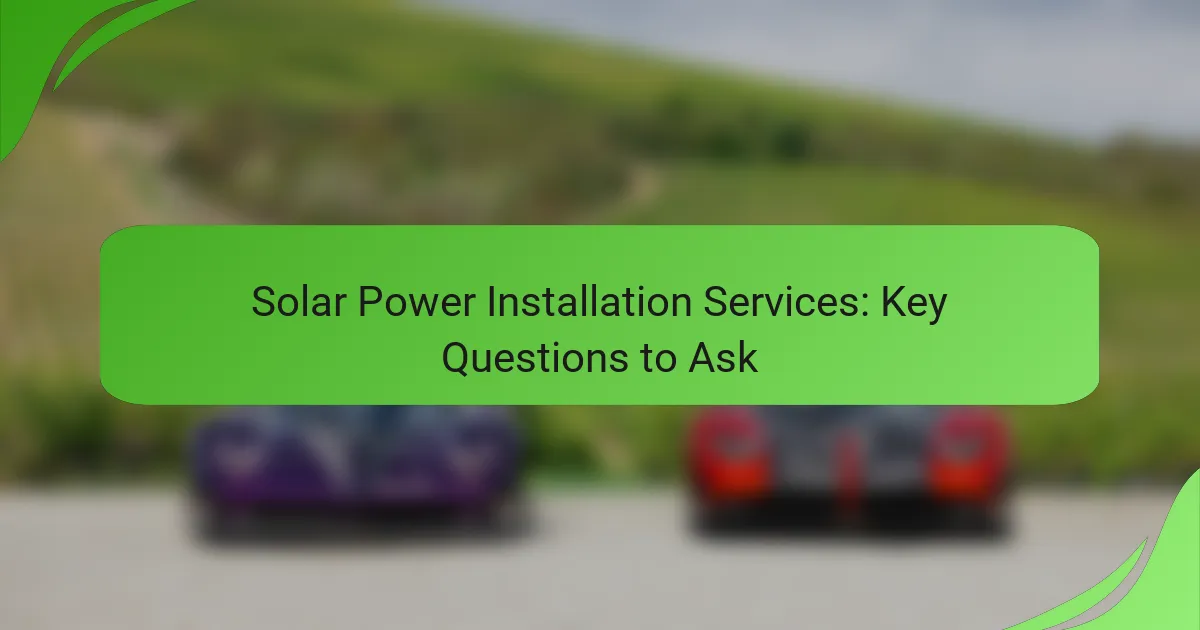Investing in solar power installation services can lead to substantial savings on energy costs while benefiting the environment and increasing your property’s value. As you explore your options, it’s essential to ask the right questions regarding the company’s experience, warranty offerings, and financing solutions to ensure a smart investment in renewable energy.

What are the benefits of solar power installation services in California?
Solar power installation services in California offer significant advantages, including reduced energy costs, a positive environmental impact, and increased property values. By harnessing abundant sunlight, homeowners can benefit from lower utility bills and contribute to a sustainable future.
Cost savings on energy bills
One of the primary benefits of solar power installation is the potential for substantial cost savings on energy bills. Homeowners can significantly reduce or even eliminate their monthly electricity expenses, depending on the size of the solar system and local energy rates.
In California, where electricity prices can be high, many homeowners see savings of 20-50% on their energy bills after installing solar panels. Additionally, state incentives and federal tax credits can further enhance these savings, making solar an economically viable option.
Environmental impact reduction
Solar power installation services contribute to a significant reduction in environmental impact. By generating clean energy, solar systems help decrease reliance on fossil fuels, which are major contributors to air pollution and climate change.
In California, transitioning to solar energy can help reduce greenhouse gas emissions by thousands of pounds per year for an average household. This shift not only benefits the planet but also aligns with California’s ambitious climate goals, encouraging a sustainable energy future.
Increased property value
Installing solar panels can enhance the value of a property, making it more attractive to potential buyers. Homes equipped with solar energy systems often sell for more than comparable homes without solar, as buyers recognize the long-term savings and environmental benefits.
Research indicates that homes with solar installations can see an increase in property value by approximately 3-4% on average. In California’s competitive real estate market, this added value can be a significant advantage when selling a home.

How much does solar power installation cost in major US cities?
The cost of solar power installation varies significantly across major US cities, typically ranging from around $15,000 to $30,000 for residential systems before incentives. Factors influencing these costs include local labor rates, system size, and available tax credits or rebates.
Average costs in Los Angeles
In Los Angeles, the average cost for solar power installation is approximately $15,000 to $25,000 for a standard residential system. This price range reflects the competitive market and the availability of various financing options, including leases and power purchase agreements.
Homeowners should consider the federal solar tax credit, which can reduce costs by about 26% for systems installed before the end of 2023. Additionally, local incentives may further decrease the overall investment.
Average costs in New York City
New York City sees average solar installation costs ranging from $20,000 to $30,000. The higher costs are often attributed to the city’s unique building regulations and labor expenses. However, the potential for savings through state incentives can make solar more accessible.
New York offers programs like the NY-Sun Initiative, which provides financial incentives to homeowners. It’s advisable to research local installers who are familiar with city regulations to ensure compliance and maximize savings.
Average costs in Chicago
In Chicago, the average cost for solar power installation typically falls between $15,000 and $22,000. The city’s solar market is growing, supported by state incentives that can significantly offset installation costs.
Illinois homeowners can benefit from the Solar Renewable Energy Credits (SRECs), which provide additional financial returns based on energy production. Engaging with local solar providers can help navigate these incentives effectively.

What questions should I ask a solar power installation company?
When considering a solar power installation company, ask questions that clarify their experience, warranty offerings, and financing options. Understanding these aspects will help you make an informed decision about your solar investment.
Experience and qualifications
Inquire about the company’s experience in solar power installations, including how long they have been in business and the number of projects completed. A reputable company should have a proven track record and be familiar with local regulations and standards.
Ask about the qualifications of their technicians. Certifications from recognized organizations, such as the North American Board of Certified Energy Practitioners (NABCEP), can indicate a higher level of expertise and professionalism.
Warranty and maintenance options
Understanding the warranty terms is crucial. Ask about the length of the warranty on both the solar panels and the installation work, as well as what is covered. Typical warranties can range from 10 to 25 years for panels and 1 to 10 years for workmanship.
Additionally, inquire about maintenance options. Some companies offer routine check-ups or monitoring services to ensure optimal performance, which can help extend the lifespan of your solar system.
Financing and incentives
Explore the financing options available through the company. Many installers provide various plans, including cash purchases, loans, or leases. Understanding these choices can help you find a solution that fits your budget.
Ask about local incentives or tax credits that may be available for solar installations. In the U.S., for example, the federal solar tax credit allows homeowners to deduct a percentage of the installation cost from their federal taxes, which can significantly reduce the overall expense.

What are the steps involved in the solar power installation process?
The solar power installation process typically includes several key steps that ensure a successful setup. These steps range from initial consultations to the final installation, each crucial for optimizing the performance of your solar system.
Initial consultation
The initial consultation is the first step where you discuss your energy needs and goals with a solar provider. This meeting helps to establish your expectations, budget, and any specific requirements you may have.
During this phase, the provider will explain the different solar technologies available, financing options, and potential savings on your energy bills. It’s also a good time to ask about warranties and maintenance services.
Site assessment
A thorough site assessment follows the initial consultation, where professionals evaluate your property for solar suitability. This includes checking roof orientation, shading from trees or buildings, and structural integrity.
They may use tools like solar pathfinders or software to analyze sunlight exposure throughout the year. This assessment is critical for determining the optimal system size and configuration for your specific location.
Installation timeline
The installation timeline can vary based on several factors, including system size and local permitting processes. Generally, the entire process from consultation to installation can take anywhere from a few weeks to several months.
Once permits are secured, installation typically takes one to three days, depending on the complexity of the system. It’s advisable to stay in contact with your provider throughout this period to address any questions or concerns that may arise.

What are the common financing options for solar power installation?
Common financing options for solar power installation include solar loans, leasing options, and power purchase agreements (PPAs). Each option has distinct features and benefits that can affect your overall investment and savings.
Solar loans
Solar loans allow homeowners to borrow money to purchase a solar energy system, which they then pay back over time, typically with interest. These loans can be secured or unsecured, with terms ranging from five to twenty years. Homeowners often see immediate savings on their energy bills, which can offset loan payments.
When considering a solar loan, check for interest rates, repayment terms, and any potential fees. Some lenders may offer special programs or incentives for energy-efficient upgrades, so it’s wise to shop around for the best deal.
Leasing options
Leasing options enable homeowners to use solar energy systems without upfront costs. In a solar lease, you pay a fixed monthly fee to use the system, while the solar provider retains ownership. This can be an attractive option for those who want to avoid maintenance responsibilities and still benefit from solar energy.
However, leasing may limit your eligibility for tax credits and incentives, as these benefits typically go to the system owner. It’s essential to review the lease terms carefully to understand the total costs and savings over the lease period.
Power purchase agreements
Power purchase agreements (PPAs) involve a contract where you agree to buy the electricity generated by a solar energy system at a predetermined rate. This rate is often lower than your local utility’s rates, leading to savings on your energy bills. The solar provider owns and maintains the system, relieving you of maintenance responsibilities.
PPAs can be beneficial for those who prefer not to make a large upfront investment. However, like leasing, you may miss out on tax incentives, as the provider claims these benefits. Always assess the long-term costs and benefits before entering into a PPA.
